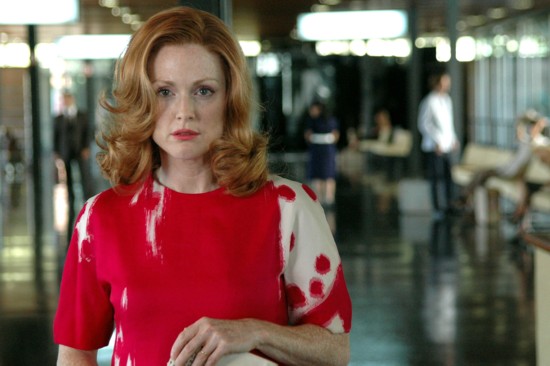FILM-FORWARD.COMReviews of Recent Independent, Foreign, & Documentary Films in Theaters and DVD/Home Video
Directed by Tom Kalin Produced by Iker Monfont, Katie Roumel, Pamela Koffler, Christine Vachon Written by Howard A. Rodman, based on the book Savage Grace by Natalie Robins & Steven M. L. Aronson Director of Photography, Juanmi Azpiroz Edited by Tom Kalin, John F. Lyons & Enara Goicoetxea Music by Fernando Velazquez Released by IFC Films Spain/France/USA. 97 min. Not Rated With Julianne Moore, Stephan Dillane & Eddie Redmayne Savage Grace, a sensationalized true tale of disturbed rich people, is a hot mess of a movie – a tale of incest divorced from subtext or perspective. The film begins in 1946 with the troubled marriage of Barbara Daly (Julianne Moore) and Brooks Baekeland (Stephan Dillane). He is a plastics heir, and she is a shop girl who has married above her class. The two are bound in a sexually-charged game, and their son, Tony (Eddie Redmayne), their only child, inhabits an uneasy role in their folie à deux. According to the young man’s grandfather, “One of the uses of money is that it allows us not to live with the consequences of our mistakes.” The family lives out this dictum in New York, Paris, and Spain until the murderous climax in London, 1972. The writer and director assume that a few moments of sexual revelation will be titillating enough to keep viewers hooked in lieu of a plot, layered character development, strong dialogue, and cohesive details. Instead, the film belly flops into a rare disaster – a boring potboiler. There’s too much stiff, stagy dialogue, and not enough social or political context. The Baekelands regularly encounter the world outside of their sick, insular lives, but those moments are only alluded to, never shown. Julianne Moore gives a serviceable performance as Barbara Baekeland, but I feel her superstar presence actually handicaps the film. Dressed in a series of brightly-colored period clothes, she’s poised like in a recent Vogue shoot. If Savage Grace featured an obscure actress as the lead, the screenwriter and director might have felt forced to give her more – more motivation, more of a character arc, and more organic lines. But clichés and predictable moments abound in this script. When Barbara goes to Brooks’s hotel room to seduce him, he sodomizes her, and we just know that later there’ll be a scene where she publicly accuses him of being gay. We see Tony eying two attractive friends, a man and a woman, on the beach and just know that he’ll sleep with both of them. Without enough context, the sexual innuendo in Savage Grace becomes tedious and repetitive, no matter which characters are involved. Meanwhile, details beyond sexual clichés remain clouded – what exactly is Brooks up to? Why do the influential women who once disapproved of Barbara suddenly have lunch with her? Does Tony quit school? How do Barbara and Tony’s finances work after Brooks ditches them to run off with the Spanish girl that Tony brings home from the beach? I haven’t read the book Savage Grace, but based on interviews with Tom Kalin, there seem to be hundreds of crucial background details that would have fleshed out the characters, yet are left out of Howard Rodman’s screenplay. One possibility is that the filmmakers got too close to the material, becoming so familiar with the key elements of the story that they forgot that they needed to reveal them to the audience.
Savage Grace had the potential to be a searing indictment of a debauched, wealthy American expat family. Instead, it’s a pulpy sex story
without a lot of sex. It could easily be a feature on Lifetime – My Son, My Lover: The Barbara Baekeland Story. Like their dissolute
characters, the filmmakers take too much for granted.
Elizabeth Bachner
|
